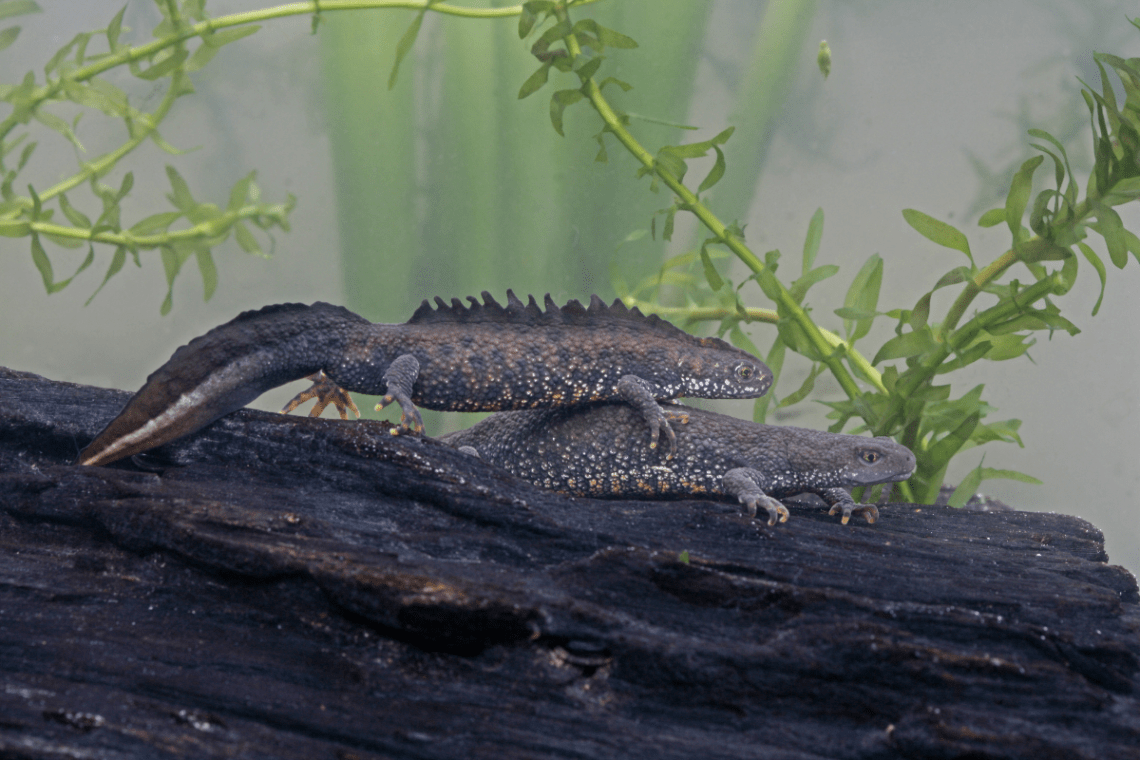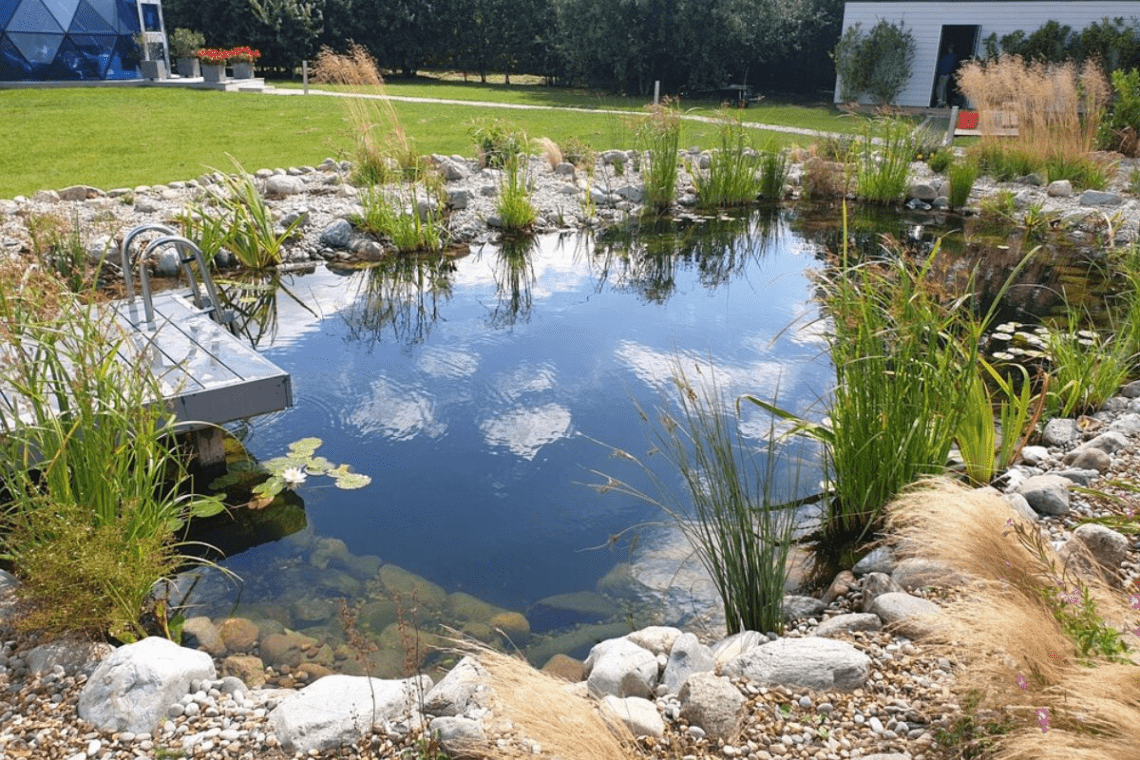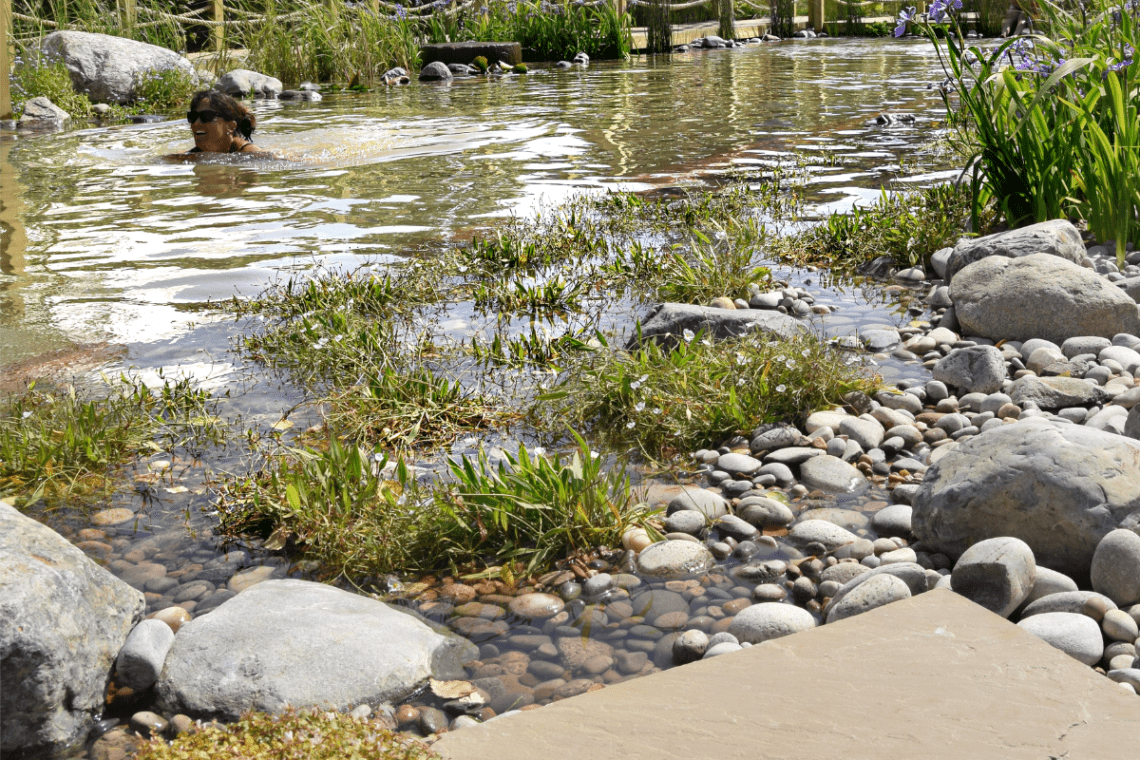Building a swimming pond can be a wonderful way to invite newts and even great crested newts (GCNs) to your garden. These remarkable creatures are one of the three newt species native to the UK, known for their unique warty skin and striking orange bellies. Swimming ponds offer a suitable habitat with unpolluted water and diverse aquatic plants that can support the needs of GCNs and their larvae.
Your swimming pond can become a high-quality habitat not only for the newts but also for a variety of other wildlife. The presence of pond plants and a natural environment attracts invertebrates, providing food and shelter essential for newt larvae. While maintaining the swimming pond for great crested newts, it is crucial to keep it free of fish, as they can be predators to the newt eggs and larvae.
Caring for a pond suitable for GCNs means understanding their life cycle and ensuring the pond’s surroundings provide the terrestrial habitat they need year-round. By following some of the tips below, you’ll be helping to create a newt-friendly ecosystem.
Understanding Great Crested Newts

Great crested newts are fascinating creatures with unique habits. Understanding their preferences is key for creating suitable habitats. They are protected under the Wildlife and Countryside Act, making their conservation vital.
Habitat Preferences
GCNs inhabit both aquatic and terrestrial environments. They thrive in ponds, such as those in gardens, especially where there are few or no small fish. These fish can eat newt larvae, reducing survival rates.
Natural ponds or restored ponds with rich vegetation provide ideal aquatic habitats. Over the summer months, newts spend significant time on land, seeking damp, shady areas. Logging land around ponds helps maintain suitable terrestrial habitat for these creatures.
Conservation Status
As a protected species, GCNs face challenges from habitat loss and urbanisation. Legal protection under the Wildlife and Countryside Act makes any harm or disturbance to them or their habitats illegal.
Organisations like Natural England work towards conserving these amphibians by promoting pond creation and restoration. Efforts led by the Newt Conservation Partnership aim to expand high-quality habitats, ensuring the survival of these wonderful creatures. Protecting existing habitats is important for their future.
Breeding Requirements
During the breeding season, from early spring to mid-summer, GCNs breed in clean, freshwater bodies. Breeding ponds need aquatic plants for egg laying and cover.
The presence of abundant vegetation supports a diverse array of freshwater species, aiding their development. It also provides places for mating rituals. Frogs and toads might share these ponds. After breeding, adults return to land, awaiting late summer for young newts to emerge.
Essentials of a Swimming Pond Ecosystem

A swimming pond is not just a place for leisure; it supports a rich ecosystem. Understanding water quality, aquatic plants, and pond structure helps create an ideal environment for great crested newts.
Water Quality and Composition
Good water quality is key to a healthy swimming pond. Maintaining a natural balance without chemicals allows creatures like newts to thrive. This involves using biological filtration and regular testing for pH, nitrates, and phosphates.
Clean water supports not only newts but also other wildlife. Proper circulation and oxygen levels keep the pond healthy.
Plants and microorganisms act as natural filters, breaking down waste and keeping water clear. Avoiding pollutants and managing runoff also help maintain suitable conditions for pond species.
Aquatic Plant Life
Aquatic plants form the backbone of a pond ecosystem. They provide hiding spots and breeding grounds for GCNs. Submerged, floating, and marginal plants each play a role in oxygenating the water and supporting life.
Submerged plants like hornwort offer cover and help in oxygenation. Floating plants, such as water lilies, shade the water and reduce algae growth. Marginal plants like reeds create habitats and help stabilise pond edges. Ensuring a diversity of plants not only benefits newts but also attracts insects and other amphibians, enhancing biodiversity.
Pond Depth and Structure
The depth and structure of a swimming pond influence which creatures it can support. Different depths cater to various wildlife needs, with shallow areas important for breeding and deeper parts providing refuge during colder months.
GCNs, for example, require both deep and shallow areas for different stages of their life cycle. Gradual slopes and a varied pond floor create microhabitats.
Gentle edges allow easy access for newts and other amphibians. Including rocks and logs offers shelter from predators and spaces for laying eggs. A well-designed pond accommodates seasonal changes and supports diverse species.
Designing a Swimming Pond for Great Crested Newts

Designing a pond with great crested newts in mind involves creating an environment that supports their unique needs. This means providing safe spaces for hiding and basking, while also making sure there’s a good balance of sunlight and shade for them.
Creating Hideouts and Basking Areas
Newts need places to hide from predators and to rest. A pond designed for newts should have loose rocks, logs, and plants. These provide safe hiding spots.
Loose rock piles or a rockery near the pond can be perfect. They offer crevices for newts to squeeze into and feel safe. Logs and branches over the pond can act as basking spots where newts warm up in the sun.
Adding vegetation such as submerged plants and overhanging leaves helps newts stay hidden while swimming. This setup mimics their natural habitat, offering safety and comfort.
Balancing Sunlight and Shade
Sunlight and shade play important roles in a newt-friendly pond. Too much sun can cause water to get too warm and lead to algae growth. Not enough sun can make the water too cold.
Newts enjoy a mix of both. To achieve this, plant tall grass or shrubs around the pond’s edge. They provide shade and lower the temperature when needed.
Meanwhile, leaving some areas of the pond open to direct sunlight supports plant growth and warms the water for newts during cooler months. This balance creates a comfortable aquatic environment, supporting the newts’ life cycle and encouraging them to breed.
Maintaining a Newt-Friendly Pond

Creating a suitable habitat for great crested newts in your garden pond involves careful planning and ongoing care. Regular maintenance and understanding seasonal needs are essential for keeping the pond environment healthy and attractive to these protected species.
Regular Monitoring and Maintenance
To support GCNs, regular monitoring and water testing of your pond’s condition is crucial. Check the water quality, looking for clear water and an absence of pollutants. Remove debris like fallen leaves or branches, which can decay and affect water quality.
Keep an eye on plant growth to prevent overcrowding. Too many plants can deplete oxygen levels.
It’s essential to control the presence of fish. Small fish can prey on newt larvae and eggs, disrupting the newt population. Regularly check the pond for invasive species that might harm the habitat and the creatures living there.
Seasonal Considerations
Each season brings different needs for maintaining a pond. Winter can be challenging, as a frozen pond surface can block oxygen from reaching the water. Use a floating ball or a pond heater to keep a small area ice-free for gas exchange.
In the summer months, monitor the water levels, as evaporation can reduce habitat space. Ensure that the pond maintains a balance of sun and shade to prevent overheating and support a warm microclimate for amphibians like newts.
Swimming ponds provide excellent habitat for great crested newts, as their regeneration zones are typically rich in vegetation, creating ideal conditions for breeding. These zones are separate from the swimming areas, ensuring minimal human interaction and disturbance during critical periods. However, construction or renovation of a pond should always be avoided during the breeding season, which typically occurs between March and June.
During this time, allowing vegetation to grow naturally is essential, offering shelter and suitable egg-laying sites for newts and other amphibians. If pond restoration is necessary to enhance its condition and support a thriving ecosystem, it should be planned outside the breeding season to avoid disruption.
Wrapping Up

Adapting your own pond for GCNs helps both you and local wildlife. GCNs, with their warty skin and orange belly, can thrive in these habitats. They need a high-quality habitat with suitable aquatic plants for breeding.
Ensuring your pond supports life not only helps these newts but also encourages other species like frogs and dragonflies. Consider planting vegetation that supports various factors of the pond ecosystem, providing shelter and food for newt larvae and other creatures.
At present, great crested newts are protected by the District Level Licensing (DLL) scheme by Natural England, even with the new government. This helps and allows developers to add to the restoration and building of ponds, which is fantastic for GCNs. It has already had encouraging results, as a high presence of the newts has been seen in restored and new ponds. If you’re interested in creating a newt-friendly swimming pond, Ponds by Michael Wheat can assist you. Feel free to contact us at 0116 218 5107 or yourjourneybegins@pondandgardendesign.co.uk.